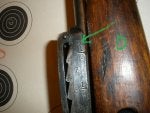What I found out about D 166 bullets as made by Lapua today.
Just was is it about D 166 bullets? Where's the magic?
First, I did all my measurements except length with a 0-1" Mitutoyo digital micrometer zero'd with the thimble and checked on a supplied standard cylinder of known diameter.
I checked for comparison a 210 gr. Sierra MatchKing HP BT bullet, which measured exactly .308 dia. no matter where on the circumference of a circle around the bullet I measured it. Perfect uniformity.
The Lapua bullets were described as "7.62 D 166 13,0 g /200 gr. FMJBT Bullet"
Bullet diameter was given on the next line as (7.87 mm/.310).
My measurements of the bottom of the D 166 bullet, taken from the "driving band" part of the bullets:
Sample - .3096", .30955", .30950", .30945" and .30930". Not a stellar exhibition of uniformity of manufacture, and not quite .310" either.
The weight was the same pattern. Slightly over the listed 200 gr., the bullets I weighed clustered around 202 gr. plus or minus a few tenths of a grain, close to my scale's .1 gr. +- error range.
Length was measured with a Mitutoyo digital caliper, which is not as accurate as the micrometer but plenty accurate for overall length of the bullet. My lengths of bullets chosen at random from the same box, were 1.3365", 1.3355", 1.3360", and 1.3335". Bullet length can be variable and not significant if the bullet is measured from the same point on the ogive with a bullet comparator, which is what I really should have done, but I am getting tired so I just measured base to tip.
Summary - I was not as impressed by the Lapual bullets as I expected to be. I sometimes use the cases and they are very nice indeed! At the diameters I measured those bullets should shoot safely in any Mosin, Finn or Russki, as long as they are not jammed up against the rifling. If you are handloading check with a home-made dummy round to be sure they are not. They may not be quite as accurate as expected because their diameters are a little smaller than advertised. I think it is quite possible that with an exposed lead base, they may obturate to fill larger diameter bores and
engage the rifling. Just a theory.
I think I will try them in my best shooting models - 39, 28, and 24, and maybe 28-30 and 28/76.
Might as well load them up and shoot them more often
(Don't go to the range without checking this, or when they call a ceasefire just after you have chambered a round, you may pull out the case, leave the bullet stuck in the throat, dump the powder in the action, and leave the bullet jammed in the rifling if you seated it out too long. Always try these at home, first. If you do think you are going to yank the case off the bullet, point the rifle straight up in the air and slowly withdraw the bulletless case until you can remove it by hand, keeping the powder in the case and not all over your bolt recesses, bolt ways, magazines, etc.)
The smaller than advertised diameter of the bullet, the slight variations in weight, length, etc. - none are significant in my opinion to make the bullet unsafe to use in appropriate handloads in any Mosin, as long as the bullet is not seated too long in a short-throat (non "D" marked) chamber. They are small enough in diameter to use in a 28/30, IMHO, and certainly no danger if they go rattling down a .313" Russian bore, just don't expect famous accuracy from that combination. Let common sense be your guide.
Interesting topic. I'm happy to learn anything I can from the comments of others.
Kari
PS USMCSean, don't forget my question.
Kari Prager







